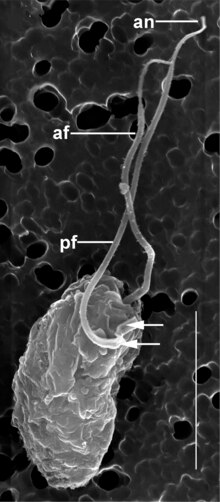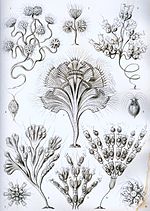 | Apicomplexans, a group of intracellular parasites, have life cycle stages that allow them to survive the wide variety of environments they are exposed... 13 KB (1,357 words) - 23:33, 22 November 2023 |
 | Apicomplexa (redirect from Apicomplexan) host cells during the parasitic stages of the Apicomplexan life cycle. Apicomplexa have complex life cycles, involving several stages and typically undergoing... 45 KB (4,846 words) - 18:11, 15 April 2024 |
 | Plasmodium vivax (section Life cycle) patients, so it is no longer in use. List of parasites (human) Apicomplexan life cycle Gametocyte Host (biology) Coatney, G. Robert; Collins, William... 43 KB (5,149 words) - 20:15, 1 February 2024 |
Trophozoite (section Life cycle stages) the liver, initiating a new cycle. Balantidium coli is the causative agent of balantidiasis. In the apicomplexan life cycle the trophozoite undergoes schizogony... 8 KB (1,001 words) - 21:36, 26 March 2024 |
 | Plasmodium (redirect from Life cycle of a malarial parasite) eukaryotes that are obligate parasites of vertebrates and insects. The life cycles of Plasmodium species involve development in a blood-feeding insect host... 43 KB (4,144 words) - 12:51, 22 April 2024 |
 | Chrompodellid (section Description and life cycle) stage in the life cycle. In addition, Vitrella produces vaucheriaxanthin. Chrompodellids are the closest living relatives of the apicomplexan parasites,... 18 KB (2,243 words) - 13:53, 17 April 2024 |
(now Apicomplexa, protists). See also sporozoite, a stage in the apicomplexan life cycle This disambiguation page lists biology articles associated with... 304 bytes (70 words) - 15:02, 1 May 2016 |
Besnoitia (section Life cycle) Besnoitia is a genus of apicomplexan parasites. The life cycle of many of the species in this genus are not known. The life cycle may be complex with various... 2 KB (82 words) - 12:46, 27 November 2022 |
Obligate parasite (section Life-cycle) parasite or holoparasite is a parasitic organism that cannot complete its life-cycle without exploiting a suitable host. If an obligate parasite cannot obtain... 16 KB (2,109 words) - 01:28, 15 April 2024 |
 | Cryptosporidium (section Life cycle) Cryptosporidium, sometimes called crypto, is an apicomplexan genus of alveolates which are parasites that can cause a respiratory and gastrointestinal... 20 KB (1,891 words) - 13:04, 30 December 2023 |
 | The Aconoidasida are a class of apicomplexan parasites created by Mehlhorn et al in 1980. Organisms in this class bear a tip at one end of their outer... 2 KB (144 words) - 19:26, 13 October 2023 |
 | Plasmodium cynomolgi (section Life cycle) Plasmodium cynomolgi is an apicomplexan parasite that infects mosquitoes and Asian Old World monkeys. In recent years, a number of natural infections of... 14 KB (1,489 words) - 03:23, 3 December 2023 |
 | Babesia microti (section Life cycle) babesiosis, a malaria-like disease which also causes fever and hemolysis. The life cycle of B. microti includes human red blood cells and is an important transfusion-transmitted... 6 KB (629 words) - 16:29, 15 April 2024 |
 | Meiosis (category Cell cycle) reductional division) is a special type of cell division of germ cells and apicomplexans in sexually-reproducing organisms that produces the gametes, the sperm... 62 KB (7,299 words) - 08:27, 9 April 2024 |
 | Gregarinasina (section Life cycle) The gregarines are a group of Apicomplexan alveolates, classified as the Gregarinasina or Gregarinia. The large (roughly half a millimeter) parasites inhabit... 16 KB (1,854 words) - 18:29, 15 April 2024 |
 | contain two nuclei: a macronucleus and a micronucleus. The schizont of apicomplexan parasites is a form of a coenocyte (i.e. a plasmodium in the general... 10 KB (1,175 words) - 03:00, 15 March 2024 |
 | Babesia (section Life cycle) Babesia, also called Nuttallia, is an apicomplexan parasite that infects red blood cells and is transmitted by ticks. Originally discovered by the Romanian... 38 KB (4,338 words) - 21:53, 9 January 2024 |
Lankesterella (Apicomplexa) (section Life cycle) Atoxoplasma, it is a genus of parasitic alveolates in the phylum Apicomplexa. Apicomplexans are obligate intracellular parasites that typically invade blood cells... 8 KB (829 words) - 18:29, 10 April 2023 |
organism in the superphylum Alveolata. It is of interest in the study of apicomplexan parasites, specifically their evolution and accordingly, their unique... 33 KB (3,751 words) - 13:02, 7 March 2024 |
Apicystis bombi (section Life cycle) transferred it to the new genus Apicystis on the basis of morphology and life cycle. This protozoan was found in Canada in overwintering queens and in males... 10 KB (1,177 words) - 00:23, 2 December 2023 |
 | Eimeria (section Life cycle) Eimeria is a genus of apicomplexan parasites that includes various species capable of causing the disease coccidiosis in animals such as cattle, poultry... 36 KB (3,724 words) - 04:12, 20 March 2024 |
 | Neospora caninum (section Life cycle and transmission) Berriman M, Pain A, Wastling JM (2012). "Comparative Genomics of the Apicomplexan Parasites Toxoplasma gondii and Neospora caninum: Coccidia Differing... 17 KB (1,803 words) - 15:20, 14 April 2024 |
 | Dinoflagellate (section Life cycle) apicomplexans (=Sporozoa) in a well-supported clade, the alveolates. The closest relatives to dinokaryotic dinoflagellates appear to be apicomplexans... 95 KB (10,290 words) - 15:54, 5 February 2024 |
 | Protozoa (section Life cycle) such as the ciliates, dinoflagellates, foraminifera, and the parasitic apicomplexans, which were moved to other groups such as Alveolata and Stramenopiles... 52 KB (5,202 words) - 09:36, 19 April 2024 |






